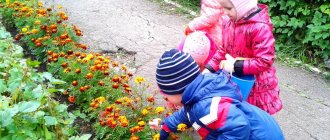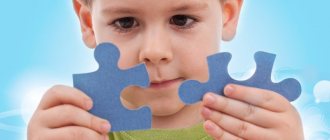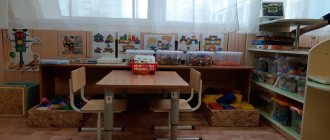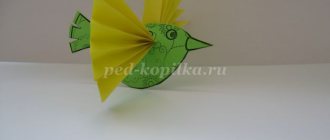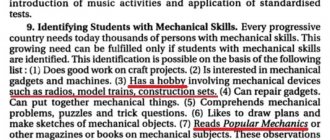“The role of construction in the development of a preschool child”
Author: Kulikova Svetlana Vladimirovna, Vorontsova Irina Aleksandrovna
The role of construction in the development of a preschool child.
The term “construction” comes from the Latin word construere, which means creating a model, constructing, putting into a certain order and the relationship of various objects, parts, elements.
Design is a practical activity aimed at obtaining a preconceived product. Children's construction is closely related to play and meets the interests of children.
Construction plays an important role in the overall mental development of the child, meets the interests and needs of children, and is cognitive and creative in nature. In the process of constructive activity, the foundations of volitional behavior are formed in the child, and thus, design activities contribute to the development of personal readiness for school.
In design, not only the direction towards achieving a certain goal is improved, but also the child’s visual perception of objects in the surrounding world. It becomes more focused; the prerequisites are created for acquiring the ability, already at preschool age, to carry out a deeper visual analysis of the model, without resorting to real dismemberment. Thus, the ability to compare and perform visual analysis is formed, including the thinking process in the process of perception.
There are two types of design: technical - this is design from building material (wooden painted or unpainted parts of geometric shape); constructing constructors from parts that have different fastening methods; construction from large-sized modular blocks and an artistic type of construction, which includes construction from paper and construction from natural materials.
Games and activities with a constructor allow a child to develop perseverance, a desire for knowledge, the ability to plan his activities and achieve results in activities that are interesting for a child.
In the process of learning to design, conditions are created for the development of creative skills, generalized methods of action are developed, and the ability to examine objects. The child learns to plan work, learns to control his actions, and correct the mistakes he has made. In this way, the design process becomes organized.
Also, the child remembers the correct geometric names of the parts of the construction kit and learns about the features of geometric bodies.
Construction contributes to the development of a child’s speech, since in the process of work he shares his ideas and motivates them.
Design plays an important role in the formation of the moral qualities of a child’s personality. It contributes to the formation of such valuable personality qualities as independence, organization, responsibility, initiative. It also develops willpower, restraint, the ability to listen to the teacher’s explanation and work in accordance with his instructions, coordinate actions with other children, and overcome difficulties in achieving the goal.
Purposeful and systematic teaching of design to a child plays a big role in preparing children for school.
It contributes to the formation of the ability to learn, reveals to him that the main meaning of activity is not only in obtaining results, but also in acquiring knowledge and skills. Such a cognitive motive causes significant changes in mental processes. These changes consist mainly in the ability to voluntarily control one’s cognitive processes, to achieve a certain level of development of mental operations, and the ability to systematically perform mental work necessary for the conscious assimilation of knowledge. comments powered by HyperComments
Benefits of the designer
The thing is that the designer has an extremely positive effect on the development of children. Children's construction sets not only develop children's fantasy and imagination, but also have a beneficial effect on the development of thinking, memory and hand motor skills (both general and fine). It has been scientifically proven that the part of the brain responsible for fine motor skills is in close connection with the speech department. So, it is the timely development of hands that will help the baby start speaking and thinking correctly in the future.
This is why it is so important to give your child his first construction set at an early age.
Scenario of the pedagogical council “Conditions for the development of constructive activity of a preschooler”
Scenario of the pedagogical council
“Conditions for the development of constructive activity of a preschooler”
Korobeynikova Alla Mikhailovna,
Methodist,
MADO "Kindergarten No. 6" Perm.
In accordance with modern regulatory documents, each educational institution must have a development program. Participating in its development and implementation of its directions is the official responsibility of all members of the teaching staff. Therefore, the work of the management team of the institution, and in particular the methodologist or deputy head for educational work with teaching staff in order to develop the institution, remains relevant. It is important to analyze and effectively use the possibilities of involving all participants in the educational process in the development of the program and its implementation. The kindergarten team has done some work during the 2015-2016 academic year. The proposed scenario of the pedagogical council is intended to make an intermediate cut of the first stage of work on the program, make adjustments and launch preparations for the next stage. It remains important for management to develop the subjective position of members of the teaching staff, therefore the pedagogical council has the form of a round table, where everyone is given the opportunity to express their opinion, make their choice and take responsibility for the chosen part of the work. This development is intended for senior teachers, methodologists and deputy heads for educational work.
The purpose of the pedagogical council:
Developing a strategy within the framework of the implementation of the development program, the goal of which is to create a center for modern means of teaching technical design and modeling “Designing Children Corporation”; Development of creative abilities of preschool children in the center.
Form of holding: “Round table”
Materials and equipment:
Multimedia – screen, projector, laptop; flipchart, paper for it, markers of different colors, magnets
Distribution of functions:
The methodologist is the leader of the teachers' council, the secretary of the teachers' council - records the main ideas and opinions, and is also the keeper of time.
Plan for the teachers' meeting:
1. Game exercise “Make a gift”
Purpose of the exercise: Involvement of teachers in the topic of teachers' council.
2. Exercise “Where are you?”
Purpose of the exercise: Teachers’ self-assessment of their contribution to the development of the institution
3. Analysis using the Dilts Pyramid model
Goal: Analysis of the activities of preschool teachers to create conditions for constructive activities of preschool children.
4. Development of further strategy as part of the implementation of the development program.
Goal: To specify further steps to create a center for technical design and modeling and develop the creative abilities of preschoolers in the center.
Holding a teachers' meeting
Teachers take seats on chairs arranged in a circle.
1. The presenter invites everyone to stand up and greet each other in a circle, making a figurative gift with a wish associated with construction.
For example, “I want to give you, Maria Sergeevna, this yellow brick, so that it, like the sun, evokes positive emotions and encourages you to new creative achievements.” OR, “I want to give you this magnetic construction set piece so that you can attract as many ideas as possible to develop creative construction in our preschoolers.” OR, “I give you this cylinder so that there are no sharp corners in your professional life,” etc.
2. Exercise “Where are you?
(What place do you occupy in the “Designing Children” Corporation). At the entrance to the hall, there is a flipchart on which the image of the “Designing Children Corporation” institution is depicted in the form of a disproportionately drawn pyramid. (see figure) teachers need to choose a magnet and attach it to the pyramid, determining their place and significance in the “Corporation”.
To understand who and how much evaluates their contribution to the development of the institution and their functional role, the presenter offers to explain their choice if desired. This exercise helps evaluate teachers in terms of motivation, desire to participate and promote projects, as well as the harmonious development of the institution.
For example, the role of the manager is to create the foundation, material, technical, and financial conditions for the development of the institution, so she placed a yellow magnet (the color of cheerfulness) in the center of the bottom of the pyramid. The role of the methodologist is the promotion of innovative ideas, optimism and faith in the achievability of the set goals, the engine of projects, therefore the yellow magnet is at the top of the pyramid. Many educators have placed the 2nd and 3rd levels of the pyramid attributing the placement to a lot of work and the results of children's achievements, but there is still significant work to be done. One specialist placed a magnet next to the pyramid, taking the position of an observer and searching for its applicability.
3. Round table. Analysis of the activities of the teaching staff according to the “Dilts Pyramid” model.
The presenter invites teachers to analyze their activities during the year in solving the problems of the development program to create conditions for the constructive activities of preschoolers using the “Dilts Pyramid” model.
Teachers are given the opportunity to unite in groups based on professional interests or carry out self-analysis individually. Time to work 5 minutes. Time to speak 1 minute.
An example of a teacher's speech:
I, as a teacher of children of the younger group (stage 1), studied in detail (stage 2) the program content in the section “Constructive-model activity”, analyzed the state of the development center for design in the group, in accordance with the principles of the organization of the RPPS (stage 3): I replenished the center – the owner and rules of the game in the center (step 2), for this purpose she systematized the building material (bricks, cubes, prisms) in accordance with the program content, laid out all the parts in containers according to the color on which there is a symbol (the part and its color), additionally developed diagrams, created thematic albums of buildings, as well as photo albums with the plot of the buildings (step 3). As part of the work of the initiative group (stage 1), my colleague and I developed recommendations for organizing design centers in groups and held a seminar for teachers of preschool educational institutions (stage 2). As the head of the Robotics center in preschool educational institutions (stage 1), I implement the municipal model of preschool educational institutions and generalize the accumulated experience in pedagogical communities of preschool educational institutions: GMO in Lego and robotics, developed programs of short-term educational practices, presented in a virtual fair of short-term educational practices of a technical orientation, preparing children to participate in a city competition in robotics. I am the head of the Robotics club as part of an additional educational service (level 3). But I am aware of the problem of low activity of parents in choosing this service. Everything I do is important to me, because it gives me some professional growth, recognition from management, and my parents trust me as a professional. My activities are reflected in my portfolio, which contributed to my certification this year for the first category (level 4). My interest in light engineering and robotics helps me actively participate in the implementation of the development program as the head of the project line for working with teachers and children. In the future, I plan to introduce robotics as a mandatory variable part of the program of our preschool educational institution in the preparatory group of the kindergarten (level 5). I believe that my personal activity in implementing the priority direction for the development of constructive creativity in preschoolers will produce results not only at the level of our institution, but will also sow germs into the engineering future of our country and advance our kindergarten in the ranking of preschool institutions of Perm education (level 6).
All significant positive changes are recorded by the secretary on a flipchart.
Then the floor is given to the working group for thematic control. (see the control plan in the appendix), the purpose of which was “Studying the state of conditions in kindergarten groups for the constructive activities of preschoolers and their compliance with the Federal State Educational Standard for Education.”
All problems are recorded on a flipchart. Time frames for solving problems are discussed.
4. The presenter, with the help of a secretary, clearly demonstrates to teachers the image of the institution’s advancement according to the development program during the academic year. And he offers to answer the questions:
- What would you change in the activities of the institution, and what would you add?
- What was not involved in the work, but was not necessary? (forms of activity, projects, project participants, social partners);
- What should change in the results, in the children, in the teachers, in the parents?
What is done?
What remains to be done?
As a result of the discussion of proposals, 5 areas of technical design were identified, from which it is necessary to select a priority area for each group of senior preschool age preschool educational institutions:
1. Design and modeling from natural and waste materials
2. Design and modeling from paper
3. Computer design
4. Robotics
5. Lightweight construction
Educators suggested stages of implementation of these directions;
- Agree on the choice of direction with parents, in this regard, develop a program for meeting with parents;
- Develop a brand for each group, a long-term thematic plan for the implementation of each direction;
- Develop a project to fill the subject-development environment in accordance with the brand;
- Organize work to find social partners in the chosen area;
- Make a list of proposals for improving the professional competence of teachers in this area?
Proposals for the draft decision of the pedagogical council
1. Create a problem group to develop directions for the development of each group of kindergarten of senior preschool age. Choose (teacher's last name) as the group leader
Subject specialists - the music director, the director of physical education - will develop proposals for activities that shape the traditions of the kindergarten.
2. Create a problem group of teachers of junior and middle groups to develop a methodological case for design in accordance with the educational program for all age groups. Select (teacher's last name) as the leader. A speech therapist teacher should develop a card index of didactic Lego games on lexical topics in order to develop the speech of preschool children and correct speech disorders. Prepare case materials by June 15, 2016, with an interim report at the final pedagogical council.
Appendix to script materials:
Thematic control plan
“A system of work to develop children’s creative abilities in constructive activities in preschool educational institutions”
from 02/08/2016 to 03/11/2016
Purpose: To study the state of conditions in kindergarten groups for the constructive activities of preschoolers and their compliance with the Federal State Educational Standard for Education.
| Control issues | Control methods | Purpose and content of control | Dates | Responsible | |
| Observation and analysis of children’s constructive activities | The degree of formation of skills and abilities corresponding to program tasks | free activity time for children and in educational activities 8.02-10.03.16 | Members of the working group, | |
| 2. System for planning constructive activities for children in groups | Plan analysis. | Reflection in the plans of educational work the organization of constructive activities (types, forms, time, methods, frequency, age appropriateness) | 15-19.02.16 | Methodist | |
| 3. Subject development environment as a condition (Construction Center), as a condition for the development of children’s constructive activities | Interview, Filling analysis | To establish the correspondence of the developmental environment in the group with educational tasks for the development of children's creative abilities in constructive activities | 22.02-26.02.16 | Working Group Members | |
| 4.Level of professional skills of educators | Questioning | To establish the teacher’s level of proficiency in methods of organizing constructive activities for preschoolers. | 1.03.16 | Working Group Members | |
| Observation of the pedagogical process. | 8.02.-11.03.16 | ||||
| Self-analysis of GCD for design | 8-12.02.16 | ||||
| 5. Effectiveness of interaction with family | Work plans, visual information, birth protocols. meetings, | Analysis of visual information for parents in the group; questioning, checking birth protocols. meetings. | 10-11.03.16 | Methodist | |
Contents of thematic control
from 02/08/2016 to 03/11/2016
I. _ Object: constructive model activities for preschool children
Control method
: Observing the constructive activities of children.
Target:
identify the degree of formation of skills, constructive-model activity skills in accordance with program objectives
Suggested working materials
: Survey maps of the level of development of constructive skills in children of different age groups.
II . Object: Subject-based development environment (Construction Center), as a condition for the development of children’s constructive activities
Target:
Identify the level of the teacher’s skills to create an environment in the group that is appropriate for the age and level of development of children and program objectives
Control method
: analysis of the subject-developmental environment in a group for the development of constructive skills in children. Interview. Filling analysis
Suggested working materials:
Protocol for examining the subject-development environment
Sh. Object: professional skills of educators - organization of educational activities, joint activities.
Target:
To establish the teacher’s level of proficiency in methods of organizing constructive activities for preschoolers.
Control method:
Questioning
,
observation of the educational process.
Suggested working materials:
Questionnaire for educators, self-analysis (oral and written). Lesson analysis map.
IV . Object: Work planning.
Target:
Planning efficiency analysis;
An object:
planning work to develop children’s constructive skills in educational activities, routine moments and play activities.
Method
: Planning Check: Construction Activities; Individual work with children; Organization of construction in independent and play activities
Suggested working materials:
Help, planning analysis diagram.
V. _ Object: Working with family
Target:
analysis of the effectiveness of interaction between preschool educational institutions and parents.
An object:
Work plans, visual information, birth protocols. meetings,
Method:
Analysis of visual information for parents in the group; questioning, checking birth protocols. meetings.
Suggested working materials
: Questionnaire for parents, visual information analysis map.
When and which designer to buy?
Children's construction sets are usually divided into groups according to the age of the children.
Construction set for children from 1 to 4 years old
At this age, it is better to choose a construction set that contains a small number of large parts to prevent the baby from swallowing them.
The process of playing with a construction set at this age is limited to building tall towers (and parents will have to do this at first to show the child the principle of the game). When the child grows up a little, he will happily build them himself. All you need to do is encourage your baby in his endeavors!
Construction set for children from 4 to 7 years old
At this age, a child can already concentrate his attention on the game for a long time and assemble more complex construction sets, but not yet without the help of his parents. Tell your child what is best to combine with what so that the end result looks like in the picture.
Pay attention to the Lego Duplo brand - this is a type of Lego construction set designed specifically for preschool children. The details in the designer are large, the plots are simple. It will be interesting for your child to assemble such a set and play with it after assembly.
Construction set for ages over 7 years
At this age, children are already ready and want to assemble more complex construction sets that represent some kind of plot and consist of a large number of different parts. For example, Lego designers have a lot of interesting sets: a pirate ship (with real pirates, treasures in chests and other paraphernalia), an underwater world, a princess’s palace and others.
You can also offer older children an iron construction set (Meccano), the parts of which are connected with special bolts and nuts. From them you can assemble entire models of trains, cars, buildings!
We think you are convinced that the construction set is an excellent educational toy, and the large assortment allows you to choose it for children of any age.
If you liked the article, please share a link to it
